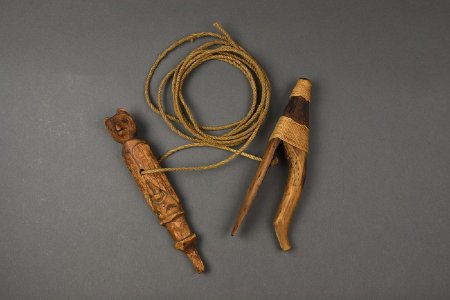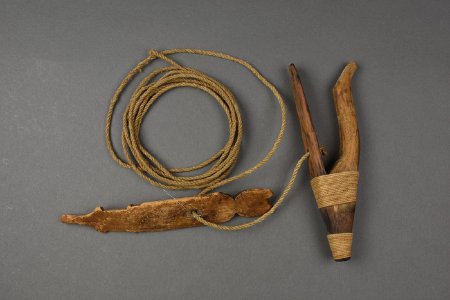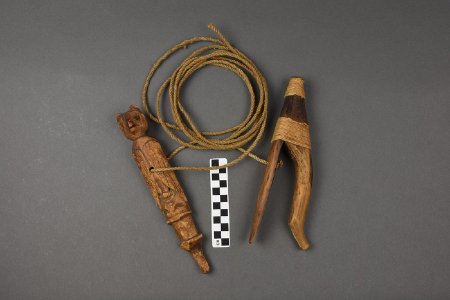Description:
Halibut Hook with Line and Carved Float
Fishing technology reveals a deep understanding of the natural world, gained through generations of adaptation. Halibut hooks are not only functional works of art, they are an expression of cultural heritage.
Traditional halibut hooks are designed to catch medium-sized halibut, sparing younger fish and large, egg-laden females. This approach perpetuates the species, preventing the depletion of a valuable resource. This knowledge has allowed Indigenous peoples to thrive here for generations.
Halibut hooks are made from two sections of wood lashed together to form a distinctive V-shape. The upper arm is carved from a light wood like yellow cedar, favored for its buoyancy. It floats above the lower arm that is carved from a heavier wood like Pacific yew or alder, favored for its longevity and toughness. One arm is usually carved with a symbolic design representing a clan or aquatic creature intended to entice the fish while the other has a sharp barb, traditionally made of bone and later, metal.
A baited hook is lowered to the sea floor with cedar bark or sinew line and stone sinkers. Octopus, salmon, fish eggs, or herring can be used for bait. The biting halibut's cheek catches on the barb and by design the more the fish struggles, the further entangled it will become. This float includes an eagle on one end and a human on the other.
Traditional halibut hooks are designed to catch medium-sized halibut, sparing younger fish and large, egg-laden females. This approach perpetuates the species, preventing the depletion of a valuable resource. This knowledge has allowed Indigenous peoples to thrive here for generations.
Halibut hooks are made from two sections of wood lashed together to form a distinctive V-shape. The upper arm is carved from a light wood like yellow cedar, favored for its buoyancy. It floats above the lower arm that is carved from a heavier wood like Pacific yew or alder, favored for its longevity and toughness. One arm is usually carved with a symbolic design representing a clan or aquatic creature intended to entice the fish while the other has a sharp barb, traditionally made of bone and later, metal.
A baited hook is lowered to the sea floor with cedar bark or sinew line and stone sinkers. Octopus, salmon, fish eggs, or herring can be used for bait. The biting halibut's cheek catches on the barb and by design the more the fish struggles, the further entangled it will become. This float includes an eagle on one end and a human on the other.
Ketchikan Museums: Tongass Historical Society Collection, THS 62.12.1.23



